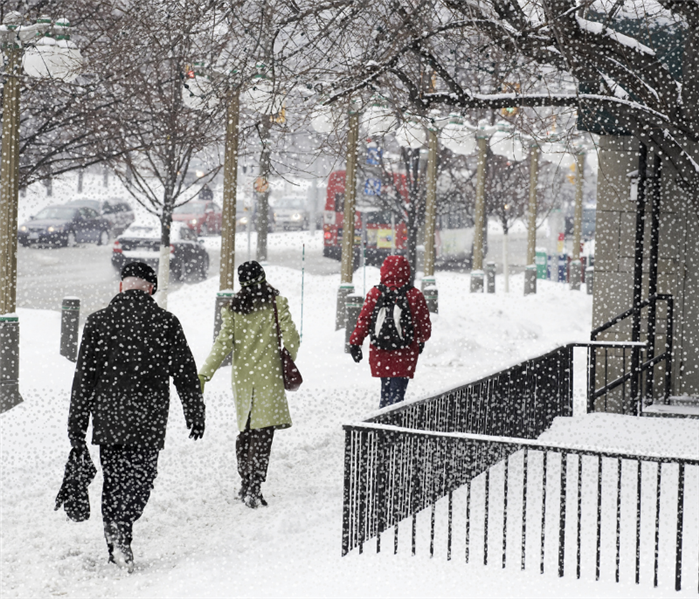Checklist For Preparing For A Blizzard
11/16/2020 (Permalink)
Here in New England, winter storms are nothing new. Most households are no stranger to preparing for snow throughout the winter season. But, there are times when extreme weather rolls through and brings blizzards that can last days and keep you snowed in for even longer.
When you know a blizzard is coming your way, you should be sure to take steps to prepare for low outdoor visibility, extreme cold, possible power outages, and even disruption to usual emergency services. Follow this checklist to prepare for a blizzard and keep your family safe and warm, even if you’re snowed in.
Preparing For A Blizzard: Checklist
- Prepare or replenish your emergency survival kit. Your kit should have all the supplies needed in the event of an emergency or major disaster, and should be able to last for days. Your kit should also be easy to carry in case you must evacuate your home. According to the Red Cross, your emergency kit should at minimum contain the following:
- Water - One gallon per person, per day
- Food - Non-perishable items that are easy to prepare, even without power
- Flashlight - Battery powered and hand-crank is best
- Radio - Battery powered or hand-crank
- Extra batteries
- Complete first aid kit
- Enough of your everyday medication to last 2 weeks
- A multi-purpose tool
- Personal hygiene items
- Copies of all important personal documents
- Cell phones and chargers
- Emergency contact information
- Extra cash
- Emergency blanket
- Pet supplies (if you have one)
- Have your vehicle ready in case of emergencies or evacuation. Fill up your gas tank and make sure it is ready to drive in the snow. Keep a shovel and kitty litter in your car in case you get stuck in the snow.
- Charge electronic devices. Make sure phones are charged along with any portable chargers you may own.
- Prepare your home. It’s best to storm proof your home every winter to keep it better insulated from the cold - but this is even more important during a blizzard, especially if you lose power. Apply weather-stripping to doors and windows and seal any cracks or air gaps. Insulate pipes, especially those on the exterior walls of your home so they do not freeze and burst during the storm.
- Gather warm clothing. In case the worst happens, having thick, layered clothing is a must to stay warm. Gather any winter hats or gloves you may also have around the house.
- Bring any outdoor animals inside or move them to a safe place. If you wouldn’t want to be out in the storm - neither do your animals. Be sure to give them enough food, water, and shelter to last the blizzard.
- Arrange for a secondary heating source. If you have a fireplace, stock up on firewood. If using a portable generator, remember to get fuel and store it in an airtight gas can (not in your living space).
- Test or install fire and carbon monoxide detectors. This is important in case the power goes out and you utilize a fireplace, portable generator, or candles for light or heat.
- Buy a snow shovel before the snow starts. Without a shovel, you may be stuck in your house for longer than planned. Getting ice melt, salt, or sand will also be helpful. We recommend purchasing all of this at the beginning of the winter season to beat the pre-storm store rush.
- Research where you can get shelter if you cannot stay in your home. If the power goes out for an extended amount of time or a tree falls on your home during the blizzard, you will want to know where the closest shelter is or have arranged to stay with friends or family.
- Learn the signs of frostbite and hypothermia. If the power goes out or you are stranded in the cold, it's important to know the signs of these so you can begin treatment right away.
- Frostbite: Causes loss of feeling and colors around your face, fingers, and toes. Skin may turn white or grayish-yellow. If you suspect frostbite, go to a warm room, soak in warm water, or use body heat to warm. Do not use a heating pad.
- Hypothermia: Unusually low body temperature, under 95 degrees. Signs of this are shivering, exhaustion, confusion, fumbling hands, memory loss, slurred speech or drowsiness. If you suspect hypothermia you can do the following: Go to a warm room, warm the center of the body first (chest, neck, head, groin), keep dry and wrapped in warm blankets.
During the Blizzard
During a blizzard, you should always stay off of the roads if possible. Visibility becomes extremely limited and it’s possible to get stuck where plows have not reached yet. If stranded in a car during a blizzard, keep warm as best you can, use your emergency kit, and call for help.
You should also stay up to date with the latest weather reports throughout the storm. This will keep you informed as to how long the blizzard will last, how much snow and ice to expect, and will provide any updates in case of evacuation.
Also be sure to keep all windows, doors, curtains, or blinds closed during a blizzard. This helps keep as much heat as possible inside your house and prevent cold drafts from outside.
If you follow the checklist above, you and your family should be able to stay safe even if your home loses power during the blizzard. Staying warm, hydrated, and eating enough should be sufficient until you can stay in a place with power or power returns to your home.






 24/7 Emergency Service
24/7 Emergency Service
